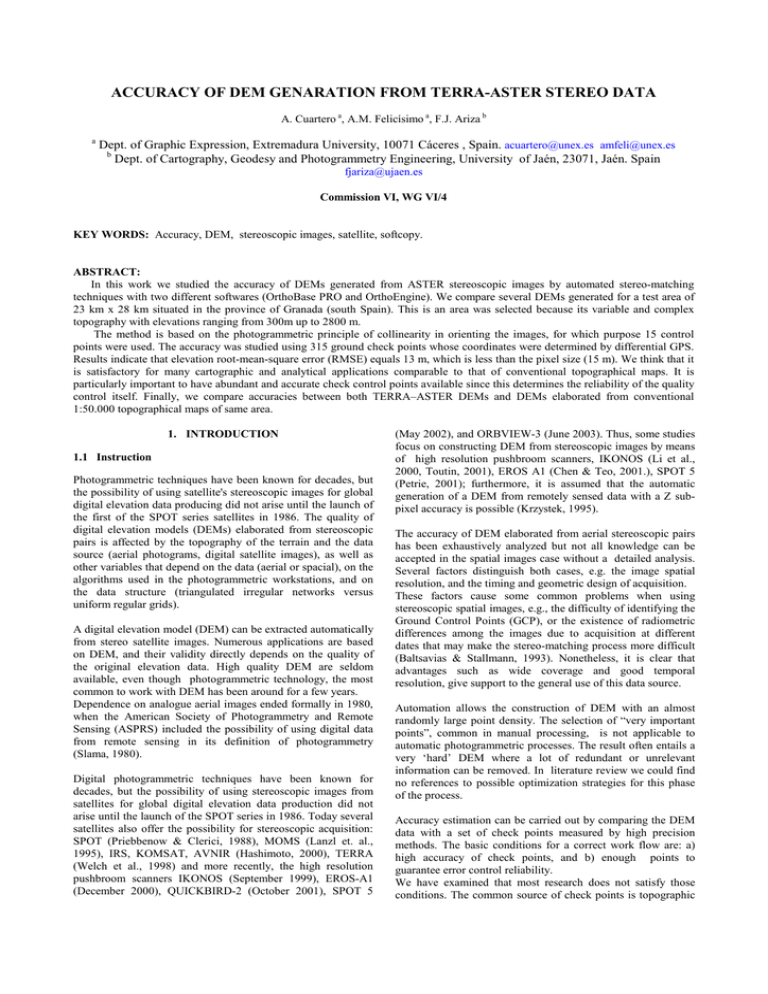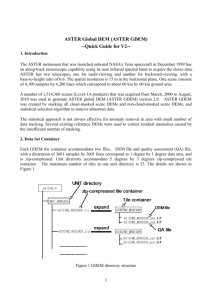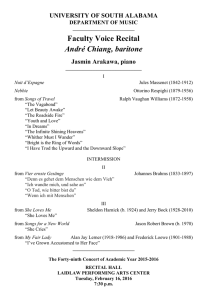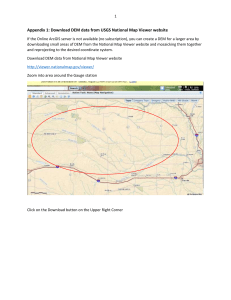ACCURACY OF DEM GENARATION FROM TERRA-ASTER STEREO DATA
advertisement

ACCURACY OF DEM GENARATION FROM TERRA-ASTER STEREO DATA A. Cuartero a, A.M. Felicísimo a, F.J. Ariza b a Dept. of Graphic Expression, Extremadura University, 10071 Cáceres , Spain. acuartero@unex.es amfeli@unex.es b Dept. of Cartography, Geodesy and Photogrammetry Engineering, University of Jaén, 23071, Jaén. Spain fjariza@ujaen.es Commission VI, WG VI/4 KEY WORDS: Accuracy, DEM, stereoscopic images, satellite, softcopy. ABSTRACT: In this work we studied the accuracy of DEMs generated from ASTER stereoscopic images by automated stereo-matching techniques with two different softwares (OrthoBase PRO and OrthoEngine). We compare several DEMs generated for a test area of 23 km x 28 km situated in the province of Granada (south Spain). This is an area was selected because its variable and complex topography with elevations ranging from 300m up to 2800 m. The method is based on the photogrammetric principle of collinearity in orienting the images, for which purpose 15 control points were used. The accuracy was studied using 315 ground check points whose coordinates were determined by differential GPS. Results indicate that elevation root-mean-square error (RMSE) equals 13 m, which is less than the pixel size (15 m). We think that it is satisfactory for many cartographic and analytical applications comparable to that of conventional topographical maps. It is particularly important to have abundant and accurate check control points available since this determines the reliability of the quality control itself. Finally, we compare accuracies between both TERRA–ASTER DEMs and DEMs elaborated from conventional 1:50.000 topographical maps of same area. 1. INTRODUCTION 1.1 Instruction Photogrammetric techniques have been known for decades, but the possibility of using satellite's stereoscopic images for global digital elevation data producing did not arise until the launch of the first of the SPOT series satellites in 1986. The quality of digital elevation models (DEMs) elaborated from stereoscopic pairs is affected by the topography of the terrain and the data source (aerial photograms, digital satellite images), as well as other variables that depend on the data (aerial or spacial), on the algorithms used in the photogrammetric workstations, and on the data structure (triangulated irregular networks versus uniform regular grids). A digital elevation model (DEM) can be extracted automatically from stereo satellite images. Numerous applications are based on DEM, and their validity directly depends on the quality of the original elevation data. High quality DEM are seldom available, even though photogrammetric technology, the most common to work with DEM has been around for a few years. Dependence on analogue aerial images ended formally in 1980, when the American Society of Photogrammetry and Remote Sensing (ASPRS) included the possibility of using digital data from remote sensing in its definition of photogrammetry (Slama, 1980). Digital photogrammetric techniques have been known for decades, but the possibility of using stereoscopic images from satellites for global digital elevation data production did not arise until the launch of the SPOT series in 1986. Today several satellites also offer the possibility for stereoscopic acquisition: SPOT (Priebbenow & Clerici, 1988), MOMS (Lanzl et. al., 1995), IRS, KOMSAT, AVNIR (Hashimoto, 2000), TERRA (Welch et al., 1998) and more recently, the high resolution pushbroom scanners IKONOS (September 1999), EROS-A1 (December 2000), QUICKBIRD-2 (October 2001), SPOT 5 (May 2002), and ORBVIEW-3 (June 2003). Thus, some studies focus on constructing DEM from stereoscopic images by means of high resolution pushbroom scanners, IKONOS (Li et al., 2000, Toutin, 2001), EROS A1 (Chen & Teo, 2001.), SPOT 5 (Petrie, 2001); furthermore, it is assumed that the automatic generation of a DEM from remotely sensed data with a Z subpixel accuracy is possible (Krzystek, 1995). The accuracy of DEM elaborated from aerial stereoscopic pairs has been exhaustively analyzed but not all knowledge can be accepted in the spatial images case without a detailed analysis. Several factors distinguish both cases, e.g. the image spatial resolution, and the timing and geometric design of acquisition. These factors cause some common problems when using stereoscopic spatial images, e.g., the difficulty of identifying the Ground Control Points (GCP), or the existence of radiometric differences among the images due to acquisition at different dates that may make the stereo-matching process more difficult (Baltsavias & Stallmann, 1993). Nonetheless, it is clear that advantages such as wide coverage and good temporal resolution, give support to the general use of this data source. Automation allows the construction of DEM with an almost randomly large point density. The selection of “very important points”, common in manual processing, is not applicable to automatic photogrammetric processes. The result often entails a very ‘hard’ DEM where a lot of redundant or unrelevant information can be removed. In literature review we could find no references to possible optimization strategies for this phase of the process. Accuracy estimation can be carried out by comparing the DEM data with a set of check points measured by high precision methods. The basic conditions for a correct work flow are: a) high accuracy of check points, and b) enough points to guarantee error control reliability. We have examined that most research does not satisfy those conditions. The common source of check points is topographic maps, whose accuracy is not well known (e.g. see Table I). Control is also performed with a little set of points. It’s obvious that, in an accuracy analysis, control process reliability must be guaranteed. This paper relies on accuracy and its reliability by using a set of 315 randomly distributed check points whose coordinates were determined by differential GPS (DGPS) techniques. A long observation time was used to guarantee an error margin of less than 10 cm. 2. BACKGROUND ON DEM GENERATION FROM TERRA-ASTER Deriving DEM from stereoscopic satellite images is not new; however accuracy results and the method used to calculate error and reliability in DEM differ according to the literature revised. This variation may be due to the method used to estimate error in DEM as much in the number as in the source of check points used. • order to make results more consistent we have used different photogrammetric software applications: OrthoBase Pro and Ortho Engine. To compare different DEM generated by several datas source: TERRA-ASTER and SPOT-HRV data versus cartographic data. 4. MATERIAL AND METHODS 4.1 Area under study Work area is a 23 km x 28 km rectangle in the province of Granada (Southern Spain) (Fig. 1). It is an area with a complex topography: Steep slopes in the South and flat surfaces in the North. Elevations are in the range 300-2800 m with an average of 1060 m. The Advanced Spaceborne Thermal Emission and Reflection Radiometer (ASTER), on board the NASA’s TERRA satellite, was launched in December 1999. TERRA-ASTER provides along-track near-IR stereoscopic images at 15 m resolution. TERRA-ASTER is a quite recent sensor; thus there is little research that analyzes the accuracy of DEM generated, mostly on simulated ASTER data (Welch et al., 1998; Abrams & Hook, 1995; Lang & Welch, 1999). The Algorithm Theoretical Basis Document, ATBD, for ASTER Digital Elevation Models (Lang & Welch, 1999) suggests that RMSE for Z values in ASTER DEM should be in the order of 10 to 50 m, but this is a too wide range to define the accuracy of a product. There is little research focusing on possibilities in DEM generation with a variable elevation RMSE between 7 and 60 m. Table I shows results of research about accuracy in DEM derived from ASTER images. Studies about ASTER data and DEM accuracy present similar problems to those aforementioned. Important questions such as the number of check points and the measure capture method are not standardized. Some authors do not even inform about control methods. Date Reference 2001 Toutin & Cheng Kääb et al. Hirano et al. 2002 2002 a b RMSE (m) 7.9 a 18 - 60 7 - 15 works Method b 4.3 Software 6 DGPS check points Photogrammetrically derived DEM Different methods about ASTER-DEM accuracy 3. OBJECTIVES • 4.2 Image data We have used two pairs of TERRA-ASTER scenes (15 m pixel). These images were taken on on 22 nd August 2000. Root Mean Square Error. Method by which RMSE has been calculated. Table 1. Some determination. Figure 1. Study area (SPOT image dropped over DEM). This paper aims: To verify the accuracy of DEM accuracy generated from stereoscopic TERRA-ASTER data. In ASTER data were processed with Erdas Imagine and Geomatica. We have used two photogrammetric programs: Erdas Imagine 8.5 with OrthoBASE Pro (Leica Geosystems). Geomatica 8.2 with OrthoEngine (PCI Geomatics). Only variying characteristics are commented below. 4.3.1 Erdas Imagine 8.5 with OrthoBase Pro OrthoBASE Pro has a specific module to work with SPOT data, but ASTER is only supported by means a generic module introducing the values for angles, B/H ratio, etc. The DEM may be generated only as a vector structure, a Triangulated Irregular Network or TIN. 4.3.2 Geomatica 8.2 with OrthoEngien OrthoEngine allows work with specific modules for a wide set of spatial data, including ASTER and SPOT. The DEM may be generated only as an uniform regular grid, URG. Test Variable analyzed Range of values OrthoBase: 5…15 OrthoEngine: 10…16 Nº of DEM by Nº of DEM by OrthoBase OrthoEngine 11 8 1 7 4.4 DEM generation: extraction of elevations 2 distribution of CPa 4 distributions 4 __ The automatic extraction of DEM is facilitated if the specific sensor model information is available. The work flow to generate each DEM is shown in Figure 2. 3 data structure TIN b / URG c 1 (only TIN) 1 (only URG) 4 size of grid OB: 100, 80, 60, 40, 20, 15, 10 m OE: 120, 60, 30, 15 m 7 4 5 algorithm of matching OrthoBase: diferent size of windows 13 __ 6 coefficient of correlation OrthoBase: 0.6 …0.95 8 __ In order to guarantee the best possible DEM that can provide TERRA-ASTER images, we have analyzed the influence of some aspects, such as number and spatial distribution of GCP, the data structure (TIN or URG), and the sample interval; depending on the software used, the algorithms and correlation coefficient threshold can also be tested. We have conducted several experiments to determine the optimal value of influential aspects like number and distribution of control points; data structure (TIN or URG); size of grid; and dependind on the software used the algorithms and correlation coeficient. Finaly, we constructed fifty five ASTER derived DEM (see Table 2). 43 DEMs generated: 12 55 a Control Points. Triangulated Irregular Network. c Uniform Regular Grid. b Table 2. Experimental Tests with ASTER images. 4.5 Accuracy and realibility DEM accuracy is estimated by a comparison with DEM Zvalues, and by contrasting many check points with “true” elevations. The pairwise comparisons allow the calculation of the Mean Error (ME), Root Mean Squere Error (RMSE), Standard Deviation (SD) or similar statistics. It’s obvious that reliability in the process is not a constant but depends on several factors. The number of chek points is an important factor in reliability because it conditions the range of stochastic variations on the SD values (Li, 1991). Another factor is obvious: The accuracy of check points must be sufficient for the control objectives. Figure 2. Common work flow of DEM generation. The estimate of errors in DEM is usually made by following the USGS recommendation of a minimum of 28 check points (U.S. Geological Survey, 1997). Li (1991) showed, however, that many more points are needed to achieve a reliability closer to what is accepted in most statistical tests. The expression that relates reliability to number of check points is: R ( e) = 1 × 100% 2(n − 1) <Equation 1> where R(e) represents the confidence value in % and n is the number of check points used in the accuracy test. As an inverse example, if we wish to obtain a SD confidence value of 5%, we need about one hundred check points. If we used 28 check points, we would reach a 20% confidence value. Therefore, the number of check points must guarantee stability in error estimates. Revised research is rather heterogeneous regarding number and accuracy of check points, and no author has verified reliability in of these results. Most research used a number of check points that proved clearly insufficient for guaranteeing the validity of error results. One article explained the use if check points from pre-existing cartography; this procedure is not recommended, as there tends to be no knowledge about the control map quality itself. Methods based on GPS constitute the ideal source to obtain these points, since they yield the coordinates with great accuracy, and also allow to plan a spatially well-distributed sample covering the whole area under analysis. influences the quality of the DEM: The best results are obtained for a cell size twice the pixel size (i.e., 30 m from TERRAASTER). Increasing of this distance among sampled points is not a good strategy because it is equivalent to a progressive generalization of the DEM structure. To ensure error reliability, we used a set of 315 randomly distributed check points whose coordinates were determined by DGPS techniques. The transformation between the WGS84 and the UTM local system was achieved by a Helmert transformation with parameters derived from observation measurements. These involved between 60 and 90 minutes at five geodetic vertices around the area, with errors inferior to 0.01 m. After the geodetic frame was determined, and the GPS processing of the check points adjusted, we were able to calculate the difference between these points and the elevation values of the DEM, and estimate the mean error, standard deviation, and RMSE. The confidence interval of the standard deviation was also calculated (see Table 3). These results may require some explaining. We believe that the main reason is an absence of specific models: Erdas can work with ASTER data, but it forces to the use of a generic model unable to take full advantage of the data. Geomatics includes an ASTER specific model that compensates the shortage of orbital parameters. 5. RESULTS 5.1 Accuracy and reliability results We constructed 55 DEM from ASTER images. Tables 2 outline the different experimental tests. A synthesis of the results is given in Table VI, which lists the values of the mean error (ME), standard deviation (SD), its confidence interval (CI=95%, α=0.05), and RMSE. In our case, Source data TERRAASTER Cartographic Software Error (m) ME a RMSE b SD Ortho Base 9,7 34,8 28,8 ±2,3 Ortho Engine -1,5 12,6 12,5 ±1,0 -1,1 7,9 7,8 ±0,6 C CI d a Mean Error Root Mean Square Error c Standard Deviation d Confidence Interval for SD (95%) b Table 3 . Error statistics for DEMs the availability of 315 check points enabled the error control to have a reliability of 96%. This value allows the RMSE confidence limits to be calculated for each DEM. Optimal findings include: • • Erdas Imagine generates the most accurate ASTERDEM (34.8 m RMSE) using 12 ground control points, a 13x13 correlation window, a correlation threshold value 0.60, defining a TIN structure. Geomatica obtains the best ASTER-DEM (12.6 m RMSE) as a URG structure (30 m cell size), using 15 ground control points., and that the Geomatica Ortho Engine does not allow changing parameters during the process. Based on the results obtained in this study, the generation of DEM from TERRA-ASTER stereo-images can be done with methods of digital restitution, leading to RMSE values less than the pixel size. The sampling interval is one of the factors that The influence of software is obvious from the experiments carried out. Erdas Imagine shows worse results from ASTER data. 5.2 ASTER DEM versus cartographic DEM Finally, ASTER-DEM have been compared with the DEM generated from a topographic map at a 1:25.000 scale. This process implies the comparison of 2.200.000 points. Comparing DEM was done by means a simple difference map algebra operator. Table IV shows the basic statistics. The accuracy statistics for this data and TERRA-ASTER-DEM are differents. We emphasize that significant errors affect the Geomatica ASTER-DEM, even though the mean difference is similar to one of Erdas ASTER-DEM. 6. CONCLUSIONS We concluded that along-track TERRA-ASTER provides an alternative for the extraction of DEM data. In addition, ASTER data is very attractive because it can be downloaded freely from its web site and is very affordable. The TERRA-ASTER images will provide the opportunity for the generation of DEM with RMSE Z-values less than the pixel size. Photogrammetric programs for estereocopic spacial data are not identical. Geomatica shows good ASTER-RMSE values, but blunders are common. On the other hand, Erdas shows bad ASTER-RMSE values, but blunders are infrequent. Ortho Engine, Geomatica, has a specific module for ASTER data, so the results are better than Erdas module, Ortho Base. At the moment, this type of programs are improving for every stereoscopic data like TERRA-ASTER. For example, the last version the ENVI (4.0) has a specific module for TERRAASTER date. We will continue working in this line, analyzing the influence in accuracy DEM according to software used, but we can not conclude about other influential factors. ACKNOWLEDGEMENTS This paper is part of the Project 2PR03A105 co-funded by the Junta de Extremadura (Consejería de Educación, Ciencia y Tecnología — II Plan Regional de Investigación, Desarrollo Tecnológico e Innovación de Extremadura) and FEDER (Fondo Europeo de Desarrollo Regional). FEDER REFERENCES References from Journals: Abrams M. and Hook S. J., 1995. Simulated ASTER data for geological studies, IEEE Transactions on Geoscience and Remote Sensing, 1, pp. 692-699. Baltsavias P. and Stallmann D., 1993. SPOT Stereo matching for Digital Terrain Model generation, 2nd Swiss Symposium on Pattern Recognition and Computer Vision, Zürich, Switzerland. Chen L. and Teo T., 2001.Orbit Adjuntment for EROS A1 High resolution satellite image, 22nd Asian Conference on Remote Sensing, Singapure. Hashimoto T., 2000. DEM generation from stereo AVNIR image. Advances in Space Research, 25, pp. 931-936. Hirano, A., Welch, R., Lang, H., (2002). “Mapping from ASTER stereo image data: DEM validation and accuracy assessment”. ISPRS Journal of Photogrammetry and Remote Sensing 1255 (2003): 1-15. Kääb A., 2002. Monitoring high-mountaing terrain deformation from repeated air- and spaceborne optical data: examples using digital aerial imagery and ASTER data, ISPRS Journal of photogrammetry & Remote Sensing, 57, pp. 39-52. Krzystek, P. 1995. New investigations into the practical performance of automatic DEM generation, ACSM/ASPRS Annual Convention, Charlotte, North Carolina. Lanzl F., Seige P., Lehmann F., and Hausknecht P., 1995. Using multispectral and stereo MOMS-02 data from the Priroda mission for remote sensing applications. ISSSR, International Symposium on Spectral Sensing Research, Melbourne, Australia,. Li R., Zhou G., Yang S., Tuell G., Schmid N. J., and Fowler C., 2000. A study of the potential attainable geometric accuracy of IKONOS satellite imagery. 19th ISPRS Congress, Amsterdam. Li Z., 1991. "Effects of Check Point on the Reliability of DTM Accuracy Estimates Obtained from experimental test" Photogrammetric Engineering & Remote Sensing, vol. 57, pp. 1333-1340. Petrie, G., 2001. The Future Direction of the SPOT Programme: Spot-5 International Conference, GeoInformatics, 4, pp. 12-17. Priebbenow R. and Clerici E. E., 1988. Cartographic applications of SPOT imagery, International Archives of Photogrammetry, 37, pp. 289-297. Toutin T. and Cheng P., 2001. DEM generation with ASTER stereo data. Earth Observation Magazine, 10, pp. 10-13. Toutin T., 2001. DEM generation from new VIR sensors: IKONOS, ASTER and Landsat-7. IEEE-IGARSS Proceedings, Sydney, Australia,. Welch R., Jordan T., Lang H., and Murakami H., 1998. ASTER as a source for topographic data in the late 1990's. IEEE Transactions on Geoscience and Remote Sensing, 36, pp. 12821289. References from Books: Slama C. C., Theurer, C. and Henriksen S. W., 1980. Manual of Photogrammetry, 4th edition ed. Falls Church, VA, USA,. References from Other Literature: Geomatica-OrthoEngine, 8.2 ed: PCI Geomatics, 2002. Lang H. and Welch R., 1999. ATBD-AST-08 Algorithm theoretical Basic document for Aster Digital Elevation Models, Standard product AST14, pp. 1-69. U.S. Geological Survey, 1997. "Digital Elevation Model" .






